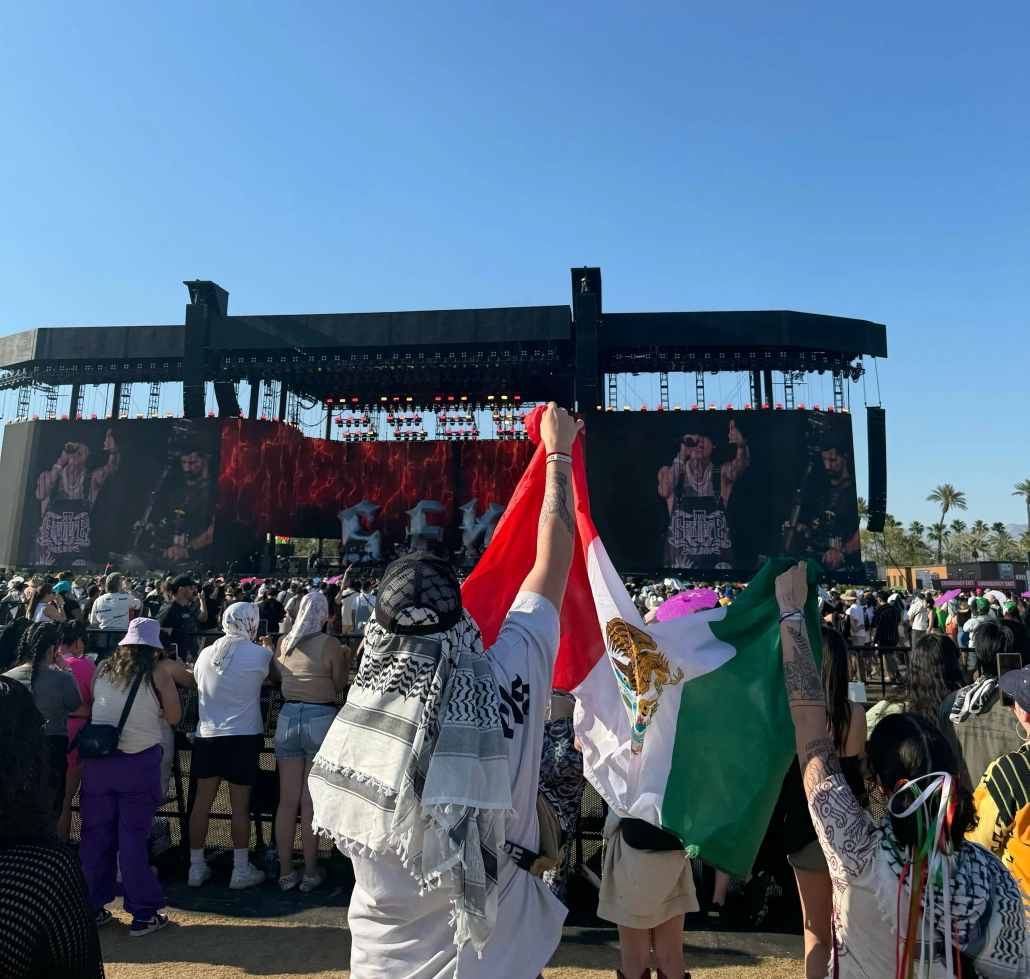El año pasado, Coachella dio la bienvenida a su primera estrella en español con el orgullosamente puertorriqueño y sensación internacional Bad Bunny. Tras las festividades de este año, una presencia mexicana inignorable impregnó el recinto del festival.
Banderas ondeaban con cada brisa seca mientras fanáticos con sombreros, trajes de charro y banderas deslumbrantes inundaban el campo en un mar de rojo, blanco y verde. El orgullo mexicano invadió a la audiencia mientras los asistentes al festival bailaban y gritaban al son de “Por Mi México” de Lefty Sm y Santa Fe Klan, gritando: “Soy mexicano, esa es mi bandera / Yo la levanto por donde quiera”.
Daily headlines, sent straight to your inbox.
Subscribe to our newsletter to keep up with the latest at and around USC.
“Tengo mi bandera mexicana, así que eso tiene que contar para algo. Estoy orgulloso. Estoy orgulloso de ser mexicano”, dijo Juan Ávila, fanático del hip-hop mexicano desde hace mucho tiempo, después de ver al Santa Fe Klan dominar el escenario principal. “Estar aquí en Coachella con [Santa Fe Klan], ya sabes, es tan grande en este momento. Y fue simplemente, quiero decir, estoy llorando un poco … Estamos rodeados de mexicanos con música mexicana y un artista mexicano, es algo fuera de este mundo”.
Los mexicanos han tenido un impacto en el Valle de Coachella desde mucho antes de que su música apareciera en los recintos del festival. Ya en la década de 1920, una afluencia de inmigrantes mexicanos encontró refugio en el Valle, huyendo de la agitación política causada por las revoluciones mexicana y cristera. Aunque estos inmigrantes desempeñaron papeles integrales en el desarrollo de Coachella, la repatriación mexicana en la década de 1930 marcó un caso en la historia estadounidense de falta constante de reconocimiento de la importancia de las contribuciones mexicanas.
Según un censo de 2020, los ciudadanos hispanos y latines representan el 97.7% de la población del Valle de Coachella. En 2024, alrededor del 10% de los artistas de Coachella eran de origen latino, un aumento del 3% respecto al año pasado. Algunos asistentes al concierto tomaron nota del cambio y dijeron que lo ven como un paso en la dirección correcta.
“Me encanta que traigan a muchos más latinos”, dijo Andre Flores, quien estaba “pasando el mejor momento de [su] vida” en su quinto Coachella.
Erika Calderón, otra asistente, también dijo que estaba contenta de ver una lista más diversa de artistas en Coachella 2024.
“Es realmente genial que haya habido tanta diversidad recientemente”, dijo Calderón. “Finalmente se están reconociendo poblaciones más grandes”.
Este aumento de representación latina es invaluable, ya que el festival del Valle finalmente está creciendo para representar a las personas que lo ocupan. Los impresionantes artistas mexicanos Peso Pluma, Santa Fe Klan y Carin León atrajeron a miles de personas al escenario de Coachella. Ya sean fanáticos de toda la vida, espectadores curiosos o personas que no hablan español, el público quedó cautivado por sus poderosas actuaciones, y cada artista alardeaba de una admiración descarada por la bandera que representa.
Este orgullo se derramó en los numerosos escenarios satélites del festival, donde artistas como Hermanos Gutiérrez, LATIN MAFIA y Son Rompe Pera impresionaron al público con sus diversos paisajes sonoros. Girl Ultra atrajo a la audiencia con la frescura de su nicho, ubicado en la intersección aparentemente improbable pero eufónica entre el R&B, el indie de finales de la década de 2000, las baladas mexicanas y el hyperpop. Combinando metales y bongós cubanos con un funk vernáculo propio, Cimafunk llevó el espíritu exuberante de La Habana al corazón del desierto.
Independientemente de lo que pueda diferenciarlos (diferentes fronteras, experiencias o influencias), los artistas latinos están unidos por todo lo que comparten sus culturas. Ya sean platos culinarios, jerga común o la experiencia universalmente aterradora de una madre latina que te llama por tu nombre completo, estos puntos culturales comunes entrelazan a la población latina en general, formando lo que el reggaetonero colombiano J Balvin llamó con orgullo la “Pandilla Latina”.
Un informe de emergencia de la década de 1950 invadió las pantallas gigantes para la presentación de Balvin, donde un presentador de noticias informó: “¡AMENAZA DE OTRO MUNDO AMENAZA EL FESTIVAL MÁS GRANDE DEL PLANETA TIERRA!” Jugando con la idea de una invasión extraterrestre, el set de temática espacial de Balvin consistió en bailarines extraterrestres y un OVNI gigante, celebrando este crecimiento en representación y resaltando el prejuicio que ha prolongado su llegada. Al traer esta “Pandilla Latina” a Indio, J Balvin dio la bienvenida al escenario a los invitados especiales María Becerra, Jowell & Randy y De La Ghetto.
Esa camaradería fue omnipresente en los terrenos de Coachella este año, posiblemente más que en el pasado. Casi todos los artistas latinos que actuaron en el escenario principal invitaron al menos a un invitado latine a unirse a ellos en el escenario.
Peso Pluma subió al escenario a seis invitados y, durante su presentación de “Lady Gaga” el viernes por la noche, honró a sus predecesores y contemporáneos con un montaje de sus íconos musicales mexicanos. La multitud rugió al ver rostros familiares y queridos, mientras personas como Sergio Vega, Jenni Rivera, Eslabón Armado y Junior H adornaban las pantallas del escenario.
Compartiendo ese escenario durante todo el fin de semana, Young Miko, J Balvin y Ludmilla reforzaron este sentido de orgullo latino al representar a Puerto Rico, Colombia y Brasil, respectivamente. Cada artista es una fusión única de sus influencias. Conmovieron a miles con sus ritmos ondulantes, adoptando de todo, desde reggaetón hasta rap, cumbia, corrido e incluso banda romántica. Aunque estos artistas apenas tocan la superficie, este tipo de representación ofrece una introducción esencial a toda la diversidad que la música latina tiene para ofrecer.
Christina Chkarboul contribuyó a este reportaje.









